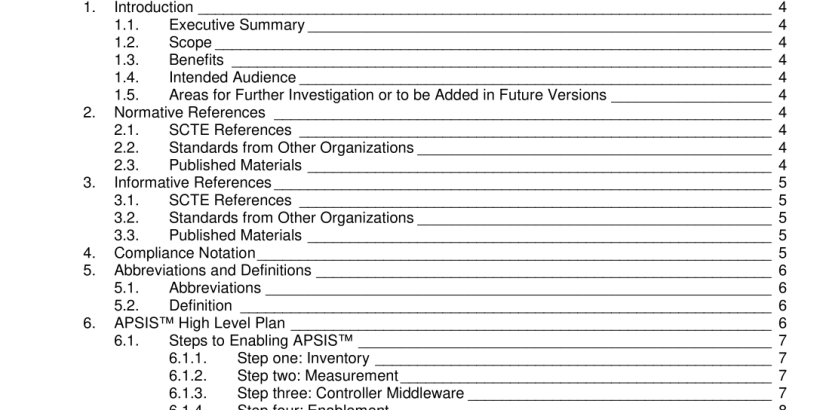ANSI SCTE 237-2017 pdf download.Implementation Steps for Adaptive Power Systems Interface Specification
The application domain encodes logic to collect and process energy measures and issue energy controls. The application layer may be composed of many independent processes executing simultaneously, and may include heavyweight ‘big data’ applications and lightweight alarm processors, and many other functions. Applications may input other data sources such as measures of service level in order to perform its tasks. The application domain may include a middleware layer to offer basic device discovery and connectivity services on behalf of all applications, greatly reducing the complexity for each energy specific application. One such middleware is the open-source OpenDaylight Software Defined Networking controller with the EMAN (Energy Management) plug-in. Annex A includes a diagram of a layered software model.
6.1. Steps to Enabling APSIS™
Implementers of APSIS shall read SCTE 216 2015 and familiarize themselves with the detailed ANSI/SCTE standard that normatively recognizes IETF’s EMAN reference as the energy management framework.
6.1.1. Step one: Inventory Inventory of devices that are able to: one) – report energy conditions via software interfaces, and two) – be controlled via these software interfaces for the amount of energy consumed in the process of enabling APSIS™ on the network. Without a solid understanding and inventory of current network-to-power awareness, unnecessary programming or missed opportunities could occur. Because few devices support APSIS™ today, this process is not programmatically supported by the APSIS™ platform and step one must be performed in an operator defined way.
6.1.2. Step two: Measurement Energy measurement is step two in the process of enabling APSIS™ on the network. Collecting a good understanding of how much power the end-to-end network consumes should help the cable operator prioritize where to target the rollout of APSIS™ based on greatest opportunity. While APSIS™ supports detailed, programmatic energy measurement, step two must be performed in an operator defined way.
6.1.3. Step three: Controller Middleware An end-to-end energy system benefits from a centralized method of device discovery, connectivity, security, and APSIS™ policy enforcement. This software layer could be custom built, integrated into an existing entity management system or an off-the-shelf package such as the open-source OpenDaylight Software Defined Networking (SDN) controller. The term ‘controller’ is used simply to refer to the set of functions that can be offloaded to a centralized set of components to relieve individual applications of the low-level details of building a network topology and interfacing directly with devices. The controller should be located at a hardened facility that can reach the furthest points on the operator’s production network. For example, a data center that meets ANSI SCTE 226 2015 Class A definition would be a logical first consideration. A controller platform should be redundant and provide high- availability, be secure, and offer reasonable performance.
6.1.4. Step four: Enablement Energy Management applications may take many forms, from offering web accessible front-ends for operational or business intelligence visualizations, to alarming, to reporting, and others. Applications receive energy measurements from devices via a controller platform or other data ingest/repository/access framework, and issue commands through controller APIs or other framework. Many applications may integrate with other service operator defined data sets, such as real-time service level metrics.
6.2. Example Scenario
The following steps outline details that represent one opportunity for implementing network energy control.
1. Set of access network devices are configured to provide energy measures and expose control functions to a centralized controller.
2. Controller establishes connections to network devices and collects energy measures, either temporarily reposing data in controller data domain or providing the measures in near real- time to application layer.
3. Energy management application collects energy measures from controller and stores data in semi-permanent repository.
4. Energy management application enforces energy policies via interactions with controller, which forwards control messages to devices.
5. Energy management application continuously monitors service delivery metrics to ensure energy policies do not disrupt services.
6. Energy management technician utilizes energy measurement application to view visualizations and generate reports of energy measurements.ANSI SCTE 237-2017 pdf download
